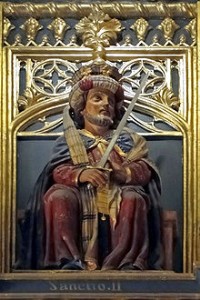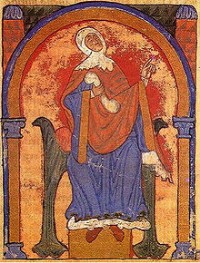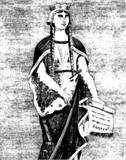Phyllis Ann Boutwell and Eric Gordon Dearborn
Person Page 560
Pedigree
Egbert II
M, #13976, b. estimated 1064, d. 3 July 1090
Parents
| Father | Egbert I & von Braunschweig (b. 1036, d. 11 January 1068) |
| Mother | Ermengarde & of Turin (b. estimated 1010, d. before 29 April 1078) |
Events
- 1064BirthEstimated 1064
- 1090~26
| Last Edited | 26 August 2022 07:05:53 |
Citations
- [S979] Our Royal, Titled, Noble and Commoner Ancestors
Pedigree
Dietrich II of Katlenburg
M, #13977, b. estimated 1045, d. 20 January 1085
Parents
| Father | Dietrich I of Katlenburg (b. estimated 1020) |
| Mother | Bertrada of Holland (b. estimated 1025) |
Family: Gertrude & von Brunswick (b. 1065, d. 9 December 1117)
| Son | Dietrich III Katlenburg (b. 1085, d. 12 August 1106) |
Events
- 1045BirthEstimated 1045
- 1056~11Title1056Dietrich II of Katlenburg held the title Count of Rittigau.
- 1085~40
| Last Edited | 28 February 2025 05:57:08 |
Citations
- [S979] Our Royal, Titled, Noble and Commoner Ancestors
Pedigree
Henry I of Eilenburg
M, #13978, b. 1070, d. 1103
Family: Gertrude & von Brunswick (b. 1065, d. 9 December 1117)
| Son | Henry II (b. 1103, d. 1123) |
Events
- TitleHenry I of Eilenburg held the title Count of Eilenburg.
- 1070Birth1070
- 1103~33Death1103
| Last Edited | 28 February 2025 05:32:10 |
Pedigree
Lothar of Supplingenburg
M, #13979, b. estimated 1090
Family: Richenza of Northeim (b. 1095, d. 10 June 1141)
| Daughter | Gertrud of Supplingenburg (b. 1115) |
Events
- Occupation
- TitleLothar of Supplingenburg held the title Emperor of the Holy Roman Empire.
- 1090BirthEstimated 1090
| Last Edited | 28 February 2025 07:45:37 |
Pedigree
Henry
M, #13980, d. 1139
Events
- TitleHenry held the title Duke of Bavaria.
- 1139Death1139
| Last Edited | 28 February 2025 06:57:00 |
Pedigree
Gertrud of Supplingenburg
F, #13981, b. 1115
Parents
| Father | Lothar of Supplingenburg (b. estimated 1090) |
| Mother | Richenza of Northeim (b. 1095, d. 10 June 1141) |
Events
- 1115Birth1115
| Last Edited | 10 October 2011 13:27:25 |
Pedigree

Sancho II of ("The Strong") Leon and Castile
M, #13983, b. 1036, d. 7 October 1072
Parents
| Father | Fernando I & ("The Great") (b. 1016, d. 24 December 1065) |
| Mother | Sancha & de Leon (b. 1013, d. 7 November 1067) |

Sancho II of Leon and Castile
Events
- 1036Birth1036 | Burgos, Castile-Leon, Spain
- TitleFrom 1065 to 1072Sancho II of ("The Strong") Leon and Castile held the title King of Castile.
- 1072~36Title1072He held the title King of Leon.
- 1072~36Death7 October 1072 | Zamora, Leon, Spain
| Last Edited | 1 March 2025 06:15:28 |
Pedigree
Garcia II of Galicia
M, #13984, b. 1042, d. 1095
Parents
| Father | Fernando I & ("The Great") (b. 1016, d. 24 December 1065) |
| Mother | Sancha & de Leon (b. 1013, d. 7 November 1067) |
Events
- NoteGarcía II (c. 1042 – March 22, 1090 AD), King of Galicia and Portugal,[1] was the youngest of the three sons and heirs of Ferdinand I, King of Castile and León, and Sancha of León, whose Leonese inheritance included the lands García would be given.
In the 1065 division of his father's estates, García was given the Galicia, including the County of Portugal, as well as the right to parias from the Taifas of Badajoz and Seville. Calling himself 'King of Galicia and Portugal', he thus becoming the first to use the title King of Portugal. His power in the south of his polity was somewhat limited until 1071, when he defeated rebel Portuguese Count Nuno Mendes in the Battle of Pedroso. However, shortly after this victory, his brothers united against him and forced García to flee to Seville, partitioned his kingdom between them.
Sancho then annexed the remainder of what had been García's kingdom along with the rest of Alfonso's Kingdom of León but was assassinated in 1072. The reunited kingdom of their father passed to Alfonso, and García then returned from his exile. It is unclear if he hoped to reestablish himself in his kingdom or had been misled by promises of safety from Alfonso, but García was immediately imprisoned in a monastery where he remained until his death sometime around 1090. - 1042Birth1042 | Castile, Spain
- TitleFrom 1065 to 1071Garcia II of Galicia held the title King of Galicia.
- TitleFrom 1065 to 1071He held the title King of Portugal.
- 1095~53
| Last Edited | 2 March 2025 07:36:39 |
Citations
- [S487] The Peerage.com
Pedigree

Elvira of Toro
F, #13985, b. 1038, d. 15 November 1101
Parents
| Father | Fernando I & ("The Great") (b. 1016, d. 24 December 1065) |
| Mother | Sancha & de Leon (b. 1013, d. 7 November 1067) |

Elvira of Toro
Events
- Note
Dona Elvira ( 1038/9 - 15 November 1101) was a Leonese infanta and the Lady of Toro. She was a daughter of Ferdinand I of León and wife Sancha. She made an important donation of lands to the monastery of San Salvador de Oña in the year 1087. She received the city of Toro on the death of her father, while her sister Urraca received Zamora, and her brothers Sancho II, Alfonso VI and García received the kingdoms of Castile, León, and Galicia respectively. - 1038Birth1038 | Burgos, Castile-Leon, Spain
- 1101~63Death15 November 1101 | Toro, Zamora, Castile-Leon, Spain
| Last Edited | 20 December 2011 06:39:39 |
Pedigree

Urraca de Zamora1
F, #13986, b. 1034, d. 15 November 1101
Parents
| Father | Fernando I & ("The Great") (b. 1016, d. 24 December 1065) |
| Mother | Sancha & de Leon (b. 1013, d. 7 November 1067) |

Urraca
Events
- NoteUrraca (1033/4 – 1101) was a Leonese infanta, one of the five children of Ferdinand I the Great, who received the city of Zamora as her inheritance and exercised palatine authority in it. Her story was romanticized in the cantar de gesta called the Cantar de Mio Cid, and Robert Southey's Chronicle of the Cid.
Before his death in 1065, Ferdinand divided his widespread conquests in central Spain between his five children, charging them to live at peace with one another. Ferdinand's oldest son Sancho II of Castile (the Strong); received Castile and the tribute from Zaragoza; Alfonso VI (the Brave) received León and the tribute from Toledo; and García received Galicia. His daughters, Elvira and Urraca, received Toro and Zamora respectively.
Sancho however resolved to rule over his father's entire kingdom and made war on his siblings. By 1072, Sancho had overthrown his youngest brother Garcia, and forced his other brother Alfonso to flee to his Moorish vassal city of Toledo. Toro, the city of Sancho's sister Elvira, fell easily. But in a siege of Urraca's better-defended city of Zamora, King Sancho was stalled, and was then mysteriously assassinated on 7 October 1072. It was widely suspected that the assassination was a result of a pact between Alfonso and Urraca. The Chronicle of the Cid, purportedly written by one of the Cid's followers, states that the assassin was a nobleman of Zamora, who then received sanctuary in the city. The chronicle is careful not to place any direct blame on Alfonso or Urraca, just as it takes pains to stress that the participation of the Cid at the siege of Zamora was involuntary and supposedly forced on him by King Sancho.
The Castilian nobility, however, were highly suspicious of both Urraca and Alfonso, and maintained the siege of Zamora for a period after Sancho's death. In the absence of Sancho, however, their siege was pointless. According to the chronicle, the guilt of Zamora was decided by a trial by combat, which proved inconclusive. Urraca sent summonses to the nobles of Sancho's dominions, calling on them to gather, and Alfonso was grudgingly acknowledged as heir to all of the Castilian realm as well as León. Suspicion, however, remained and, led by the Cid and a dozen "oath-helpers," the nobles forced Alfonso to swear to his innocence publicly in front of St. Gadea's Church in Burgos. From this incident dated Alfonso's later antagonism to the Cid.
The Chronicle of the Cid states that in his early years as King, Alfonso followed Urraca's advice in all respects. There were even rumors of an incestuous relationship between the pair. Urraca maintained her rule over Zamora following Alfonso's succession to the Castilian throne. In her later years she gradually gave up her governing duties, finally retiring to a monastery in Leon, where she died in 1101. She is interred in the Chapel of the Kings at the Basílica of San Isidoro of León.
Following the death of his son, Sancho, fighting Muslim forces, Alfonso VI was eventually succeeded by his daughter, Queen Urraca of León.
[edit] Literature and film
Urraca of Zamora, nineteenth-century romanticized depiction.
In the poetic legend, Dona Urraca is the wronged infanta, watching Sancho and the Cid despoil her lands from the battlements of her castle shortly before Sancho is murdered. Her brother Alfonso is her loyal and chivalrous defender.
The Hollywood film El Cid largely follows the narrative of the Chronicle and the poetic epics, adding to the character of the Infanta a spurned woman role scheming against the Cid, once she seems rejected by him; however it omits the story that Urraca and Rodrigo grew up as close companions in Zamora and maybe more is behind omitted. And it stretches the psychological card that as older and provoking sister she plays between her brothers Alfonso and Sancho's quarrels for her city and herself. Later in the film, after the death of the haughty older brother Sancho, she focuses her favours to extract from Alfonso compensation to her own grudges with Roy Diaz. For some reason the film wrongly makes Urraca the ruler of Calahorra, rather than Zamora. Urraca is portrayed by the French actress Geneviève Page. - 1034
- 1101~67Death15 November 1101
| Last Edited | 22 May 2022 10:05:32 |
Citations
- [S487] The Peerage.com
Pedigree
Helisinde & de Ramerupt1
F, #13987, b. estimated 825, d. 870
Family: Hilduin I & (b. estimated 820)
| Son | Helgaud II &+ (b. estimated 840, d. about 925) |
Events
| Last Edited | 9 June 2024 05:34:23 |
Citations
- [S979] Our Royal, Titled, Noble and Commoner Ancestors
Pedigree
Aethelmaer Cild & ("The Great")1,2
M, #13989, b. 931, d. 17 October 1015
Parents
| Father | Aethelwold & (b. estimated 940) |
| Mother | Aelfthryth & of Devon (b. 945, d. 17 November 1000) |
Family: Aethelthrith & of Wessex (b. 938, d. 1017)
| Son | Wulfnoth Cild &+ (b. 937, d. 1014) |
Events
- 931Birth931 | Sussex, Devon, England
- 1015~84
| Last Edited | 9 June 2024 05:34:23 |
Citations
Pedigree
Aethelthrith & of Wessex1,2
F, #13990, b. 938, d. 1017
Family: Aethelmaer Cild & ("The Great") (b. 931, d. 17 October 1015)
| Son | Wulfnoth Cild &+ (b. 937, d. 1014) |
Events
- Name EthelthrythCitation: 1
- 938Birth938 | Wessex, Devonshire, England
- 1017~79Death1017 | Wessex, Devonshire, England
| Last Edited | 9 June 2024 05:34:23 |
Citations
Pedigree
Hugh Gospatric of Port
M, #13993, b. 1005, d. 1082
Parents
| Father | Hugh Gospatric of Port (b. estimated 996, d. 1056) |
Family: Sybil (b. 1005, d. 1096)
| Son | Hugh of Port+ (b. 1015, d. 1066) |
Events
- 1005Birth1005 | Port, Calvados, Basse-Normany, France
- 1082~77Death1082 | Port, Calvados, Basse-Normany, France
| Last Edited | 9 July 2023 05:49:01 |
Pedigree
Sybil
F, #13994, b. 1005, d. 1096
Family: Hugh Gospatric of Port (b. 1005, d. 1082)
| Son | Hugh of Port+ (b. 1015, d. 1066) |
Events
- 1005Birth1005 | Scarborough, North Riding, Yorkshire, England
- 1096~91Death1096 | Basing, Hampshire, England
| Last Edited | 9 July 2023 05:48:56 |
Pedigree
Roger FitzGerold
M, #13997, b. estimated 1065, d. 1097
Family: Lucy & de Bolingbroke (b. 1070, d. 1138)
| Child | William de Roumare (b. estimated 1090) |
Events
- 1065BirthEstimated 1065
- 1097~32Death1097
| Last Edited | 30 October 2011 17:00:12 |
Pedigree
William de Roumare1
U, #13998, b. estimated 1090
Parents
| Father | Roger FitzGerold (b. estimated 1065, d. 1097) |
| Mother | Lucy & de Bolingbroke (b. 1070, d. 1138) |
Events
- 1090BirthEstimated 1090
| Last Edited | 3 May 2022 07:02:36 |
Citations
- [S487] The Peerage.com
Pedigree
Elijah + Hubbard
M, #14000, b. 24 November 1766, d. 25 May 1859
Parents
| Father | Elijah + Hubbard (b. 1746, d. 14 September 1818) |
| Mother | Hulda + House (b. 1746, d. 16 July 1785) |
Family 1: Mariam Amsden (b. estimated 1770, d. 7 January 1794)
| Daughter | Lovina Hubbard (b. 2 October 1788) |
| Daughter | Patty Hubbard (b. 20 April 1790) |
| Son | Harvey Hubbard (b. 26 May 1792) |
Family 2: Hannah + Clark (b. June 1767, d. 12 March 1864)
| Son | Thomas Clark Hubbard (b. 8 August 1795) |
| Daughter | Miriam Hubbard (b. 7 March 1797) |
| Daughter | Mona Hubbard (b. 23 January 1799) |
| Daughter | Sybil + Hubbard+ (b. 1800, d. 29 August 1892) |
| Son | Elnathan Hubbard (b. 23 November 1804) |
| Daughter | Dolly Hubbard (b. 28 December 1808) |
| Daughter | Prudence Hubbard (b. 8 August 1811) |
Events
- 1766Birth24 November 1766 | Farmington, Hartford, CT, US
- 178821
- 1794~28Marriage | Hannah + Clark1794 | Reading, Middlesex, MA, USAge: ~27Birth: June 1767 | Amherst, Hampshire, MA, USDeath: 12 March 1864 | Plymouth, Windsor, VT, US
- 1850~84
- 185992
| Last Edited | 30 January 2015 09:00:16 |